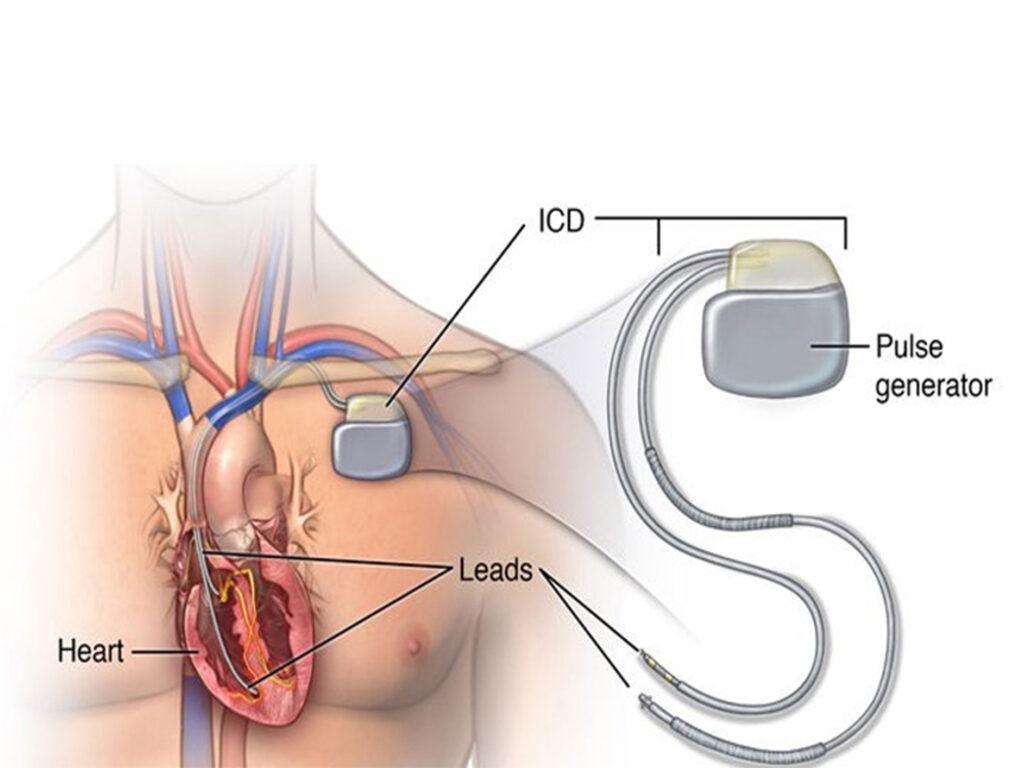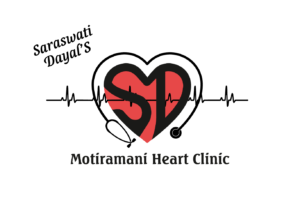Pacemaker & ICD
Saraswati Dayal’s Motiramani Heart Clinic is one of the most trusted Pacemaker & ICD Clinics in Shankar Nagar, Raipur Chhattisgarh, India.

What Is a Pacemaker?
Pacemaker & ICD It’s a small device placed under your skin in your upper chest. The pacemaker has a computer that senses when your heart beats at the wrong speed or out of rhythm. When that happens, it sends out electrical pulses to keep your heart at a steady rhythm and rate.
Why Would You Need One?
You might need a pacemaker if:
- Your heart beats too slow or unevenly and other treatments haven’t helped.
- You have an ablation procedure. This burns off tiny areas of your heart that trigger abnormal electrical impulses. Sometimes the doctor will destroy a section of your heart called the AV node. This is where electrical signals pass from the atria to the ventricles. After this procedure, you will need a pacemaker to regulate your heart rhythm.
- You take certain heart medicines. Beta-blockers and some other heart medications can slow your heartbeat. You might need a pacemaker to speed up the beat.
How Is a Pacemaker Implanted?
Saraswati Dayal’s Motiramani Heart Clinic is one of the most trusted Pacemaker & ICD Clinics in Shankar Nagar, Raipur Chhattisgarh, India.
Before your surgery, you might need to take an antibiotic, a type of medicine that kills bacteria. Your cardiologist may ask you to stop taking certain other medications, such as blood thinners. You’ll need to stop eating about 8 hours before your surgery.
You’ll have the surgery at a hospital. You’ll get medicine to relax you and prevent pain.
The doctor will thread the pacemaker wires (called “leads”) through a blood vessel into your heart. Then, they will make a small cut in your chest. They will insert the pacemaker just under your collarbone. It contains a small computer and a battery.
Usually, it will go on the side you don’t use most of the time. If you’re right-handed, it will go on your left side.
Leads will connect the pacemaker to your heart. Electrical signals will travel down the leads. These signals will adjust your heart rate if it gets too slow or too fast. Your doctor will test the device to make sure it works.
Risks of Pacemaker Surgery
Any surgery can carry the chance of complications. With pacemaker surgery, you may have bleeding and bruising. Other possible problems include:
- Damage to a blood vessel or nerve
- Infection
- Punctured or collapsed lung
What Happens Afterward?
You may stay in the hospital overnight to make sure the pacemaker is working. You might have some pain and swelling in the area where it was placed for a few days afterward.
Most people can go back to their normal routine within a few days of getting a pacemaker. You might need to avoid lifting anything heavy for the rest of your life and playing contact sports that could damage it. Talk to your doctor about how much you can do.
Your doctor will check your pacemaker once every 6 months. During the checkup, they will make sure:
- The battery works
- The wires are still in place
- The pacemaker is keeping your heart in rhythm
Batteries need to be replaced every 5 to 15 years. You’ll have minor surgery to switch them.
What is an implantable cardioverter defibrillator?
An implantable cardioverter defibrillator (ICD) is a small electronic device connected to the heart. It is used to continuously monitor and help regulate potentially fast and life-threatening electrical problems with the heart.
A transvenous or “traditional” ICD, about the size of a stopwatch, is implanted under the skin just below the collarbone. It consists of a pulse generator and wires, called leads. The pulse generator contains the battery and a tiny computer. One or more lead wires connect the pulse generator to specific locations in the heart.
The ICD responds to irregular life-threatening heart rhythms from the lower chambers of the heart with pacing that corrects a fast rhythm and promotes a normal heartbeat, or a shock (defibrillation) that resets the heart rhythm to prevent sudden cardiac arrest. An ICD also records and stores information about your heart rhythm and therapies delivered by the ICD for your doctor to review.
Most people are unaware when the ICD is pacing the heart. But, a defibrillation shock is described by many as feeling like a “kick in the chest.”
An ICD can also be programmed to work as a basic pacemaker as needed. Sometimes after a shock is delivered, the heart may beat too slowly. The ICD has a “back-up” pacemaker, which can stimulate the heart to beat faster until the normal heart rhythm returns. The ICD can act as a pacemaker any time the heart rate drops below a preset rate.
For those patients who do not require either “back-up” pacing or Anti-Tachycardia Pacing (ATP), a Subcutaneous Implantable Defibrillator (S-ICD) is available. It allows for the delivery of high-energy shocks while avoiding the potential risks and complications associated with leads that traverse the veins leading to the heart.
Why Would You Need an ICD?
You might need an ICD if the rhythm of your heart’s lower chambers, called the ventricles, is dangerously abnormal.
You might also need one if you’ve had a heart attack or cardiac arrest, which is when your heart stops working. An ICD could save your life if your abnormal heart rhythm becomes life-threatening.
How Is It Implanted?
You may have to take an antibiotic before the surgery. And, your doctor might ask you to stop taking certain medicines, such as blood thinners. You’ll have to stop eating and drinking about 8 hours before your surgery.
You’ll get medicine to relax you and so you don’t feel pain. Also, you might be given something so that you won’t be awake during the surgery.
The doctor will place the ICD wires into a vein and thread them into your heart. They will place the device in your chest through a small cut. They will test the ICD to make sure it works.
Risks of ICD Surgery
You could have bleeding or bruising. Other possible problems from ICD surgery include:
- Blood clots
- Damage to a blood vessel, nerves, or your heart
- Infection
- Punctured or collapsed lung
Once your ICD is in place, it might shock your heart if it beats too fast. The shock can feel intense. You might get dizzy or faint when it happens.
Sometimes you can get shocked when you don’t need it. If this happens, your doctor can reprogram your device to stop it from jolting you at the wrong time.
What Happens Afterward?
You’ll stay in the hospital for 1 to 2 days. You won’t be able to lift the elbow on the side of the ICD for 4 weeks after it’s implanted. Your doctor will tell you how soon you can go back to your normal activities. You should avoid heavy lifting and contact sports that could damage the ICD.
Your doctor will check your ICD once every 3 months to make sure it works. Keep your distance from magnetic fields that could interfere with your ICD. These include:
- Motorcycle engines
- Power plants
- Chain saws
- Cell phones (hold to the ear opposite the ICD)
- Airport security
